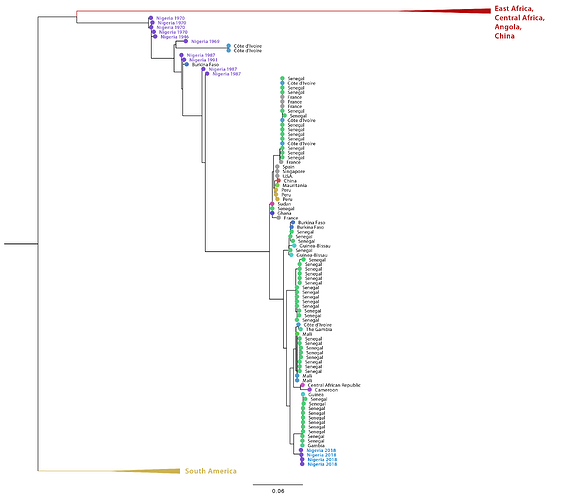In Edo State Nigeria, an area endemic for Lassa fever, 14 people with unexplained fever reported to Irrua Specialist Teaching Hospital (ISTH) in the last quarter of 2018. After ruling out infections such as Lassa fever, malaria and typhoid fever, plasma samples were sent to the African Centre of Excellence for Genomics of Infectious Diseases (ACEGID), Redeemer’s University, Ede, Nigeria, for deep sequencing and molecular characterization to determine the etiology of this outbreak. Next generation sequencing was carried out on all the samples, and 4 genomes (2 full and 2 partial) were assembled for yellow fever virus (YFV). Further analysis with RT-qPCR found 9 samples out of 14 to be positive for YFV. Nigeria has well-established vaccination programmes for yellow fever, however there are reports of a YFV outbreak since 2017.
All YFV sequences with geographical locations were obtained from GenBank and aligned with the four sequences from the 2018 outbreak. As at the time of writing this report, only one historical Nigerian whole genome was available. Thus, for this analysis we extracted approximately 680bp of the prM/E region as there are more sequences from Nigeria covering this region.
Figure 1: Maximum likelihood tree of a region of the prM/E gene of 193 YFV sequences. These sequences were aligned using MAFFT v7.310 and tree reconstruction using IQTREE v1.6.1. Old Nigerian sequences (before 1991) are coloured purple and the 2018 sequences are coloured blue.
For high quality version of the tree, see YFV_tree.pdf (233.0 KB)
Phylogenetic analysis shows that the 2018 YFV sequences all clustered together in a separate clade and are most closely related to previous sequences from Senegal. These 2018 Nigerian YFV sequences are far apart from the old Nigerian sequences, implying that the YFV in circulation is genetically different from the previous sequences reported in the country.
These are the first reported full YFV genomes since the beginning of the 2017 outbreak in Nigeria. Efforts are ongoing to better understand the diversity of YFV in the country. We therefore seek to share our pre-publication data and sequences to help the scientific community curtail the outbreak.
Data availability
All sequences are available at https://github.com/acegid/Yellow_Fever_Sequences
GenBank accession numbers will be shared when available.
Partners and Collaborators
African Centre of Excellence for Genomics of Infectious Diseases (ACEGID), Redeemer’s University, Ede, Osun State
Irrua Specialist Teaching Hospital (ISTH) Edo State, Nigeria
Nigeria Centre for Disease Control (NCDC), Abuja, Nigeria
Redeemer’s University, Ede, Osun State
Broad Institute and Harvard University, Cambridge, MA, USA
Beth Israel Deaconess Medical Center, Boston, MA, USA
Disclaimer and contact information
Please note that these analyses are based on work in progress and should be considered preliminary. Our analyses of these data are ongoing and a publication is in preparation. If you wish to use these data please contact:
Christian Happi, PhD
Professor of Molecular Biology and Genomics
Director, African Center of Excellence for Genomics of Infectious Diseases (ACEGID)
Redeemer’s University
Ede, Osun State, Nigeria
E-mail: [email protected]
Website: www.acegid.org
Paul Eniola Oluniyi
PhD student
Redeemer’s University
African Center of Excellence for Genomics of Infectious Diseases (ACEGID)
Ede, Osun State, Nigeria
E-mail: [email protected]
Website: www.acegid.org
